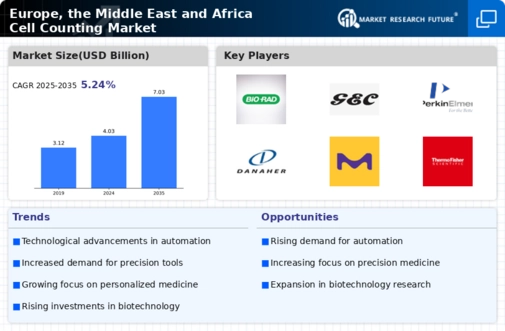Europe Cell Counting Size
Europe Cell Counting Market Growth Projections and Opportunities
The Europe, the Middle East, and Africa (EMEA) Cell Counting Market are significantly influenced by substantial investments in research and development activities. Pharmaceutical companies, biotechnology firms, and academic institutions in the region allocate resources to advance cell counting technologies, driving market growth and innovation. Ongoing technological advancements play a pivotal role in shaping the EMEA Cell Counting Market. The development of automated cell counting systems, flow cytometry, and high-content screening methods enhances the precision, speed, and efficiency of cell analysis, contributing to the market's expansion. The increasing incidence of chronic diseases and an aging population in Europe, the Middle East, and Africa drive the demand for accurate cell counting in diagnostics and disease monitoring. Cell counting technologies play a vital role in understanding cellular changes associated with aging and various health conditions. Biopharmaceutical industry growth in the EMEA region has an profound effect on cell counting market. The rise in adoption of cell counting technologies for quality control and process optimization is mostly contributed by the increased production, processing, vaccines development as well as biologics. The interest in personalized medicine increases the requirement for accurate cell-counting. The need to individualize treatment through cellular analysis poses the role of technologies for counting cells as a crucial technology in the development of personalized medicine. Collaboration and partnerships between various players in the industry, research bodies, healthcare providers promote innovation within EMEA Cell Counting Market. Joint ventures enable the creation of integrated solutions, where cell counting technologies are coupled with complementary tools for complete analysis across. The government initiatives and the funding to healthcare research also contribute in propelling market growth. Public and private investments into infrastructural development, academic research with regards to cell counting technologies as well the technological innovation create a favourable atmosphere for innovations in this area. The growing number of clinical trials and drug development activities in the EMEA region drives cell counting technology market. Cell counting with accurate measures is critical in preclinical and clinical studies to measure the potency of a drug, toxic effects if any or overall safety. Notably, the number of infectious diseases including emerging viruses highlights cell counting importance in virology and immunology research. The advancement of cell counting technologies make it easier to comprehend, immune response, viral replication and development vaccines influencing market dynamics. The educational initiatives and the workforce training programs play a part in market growth by creating awareness as well as mastery of cell counting technologies. Advanced cell counting methods are adopted due to the training programs specially developed for researchers, clinicians and laborators. Economic factors and budgetary constraints within healthcare systems impact market dynamics. While there is a demand for cutting-edge cell counting technologies, companies also focus on developing cost-effective solutions to address budget limitations in healthcare settings. The ongoing COVID-19 pandemic has accelerated the adoption of cell counting technologies for virus research, vaccine development, and monitoring immune responses. The pandemic has heightened awareness of the importance of cell counting in infectious disease research, influencing market trends.










Leave a Comment